University Project: Development of New Micro Assembled Robot
VerifiedAdded on 2021/02/22
|12
|1474
|228
Project
AI Summary
This project report details the development of a new micro assembled robot, focusing on its innovative applications and strategic considerations. The report begins with an introduction and definition of the project, followed by an analysis using the Blue Ocean Strategy framework, including a strategy canvas. The evaluation section assesses the robot's functionalities and potential market impact, emphasizing its expanded scope of use and novel features. The project identifies critical success factors (CSFs) such as hazardous area cleaning, vascular cleaning, and indoor virus cleaning, highlighting the robot's ability to operate in challenging and dangerous environments. Creative applications are explored, including bionic robot capabilities for identifying and cleaning harmful substances. The report concludes with a discussion of the robot's potential to improve safety and quality of life across various sectors. The reference section includes citations from relevant academic and industry sources to support the project's findings.
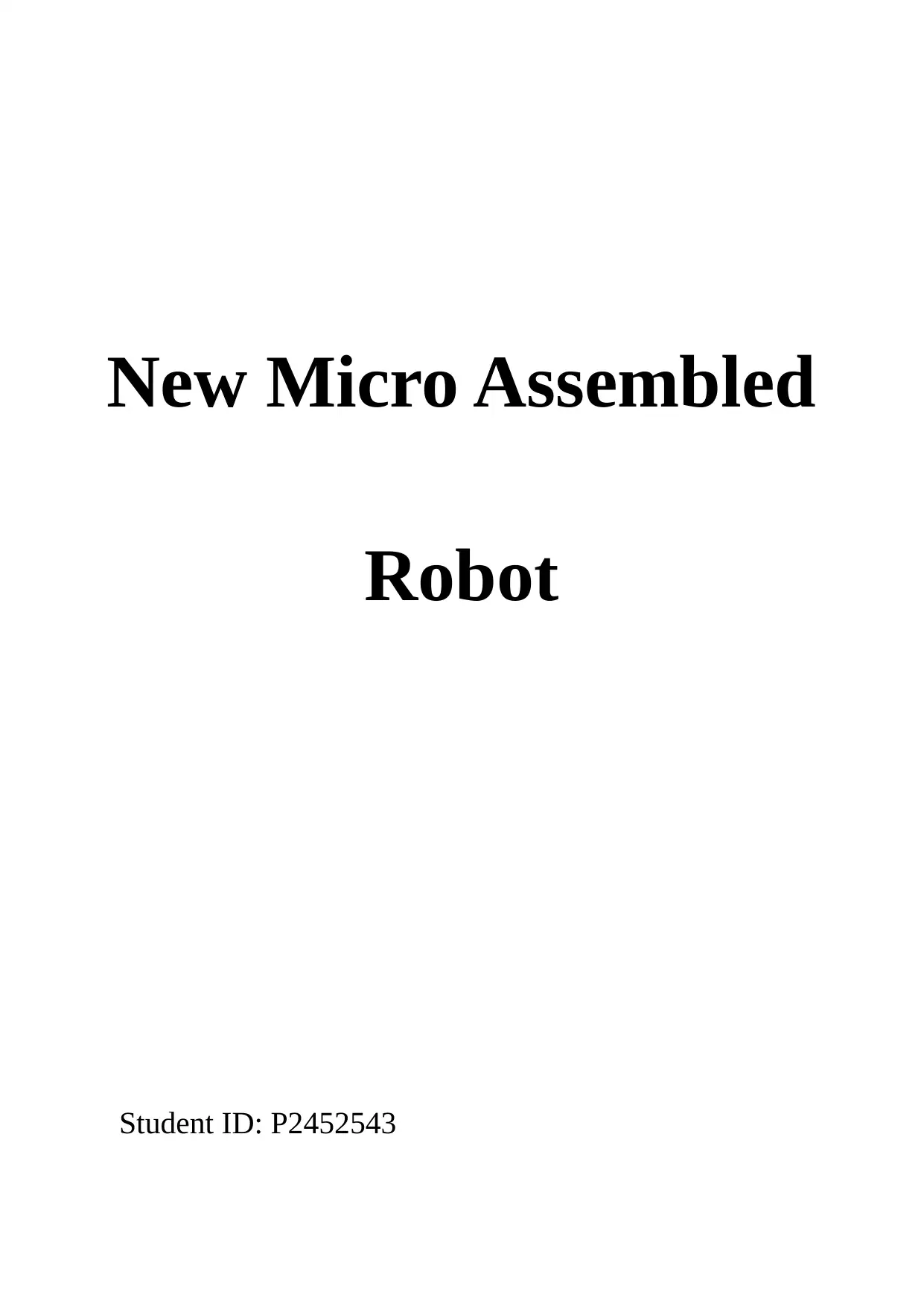
New Micro Assembled
Robot
Student ID: P2452543
Robot
Student ID: P2452543
Paraphrase This Document
Need a fresh take? Get an instant paraphrase of this document with our AI Paraphraser
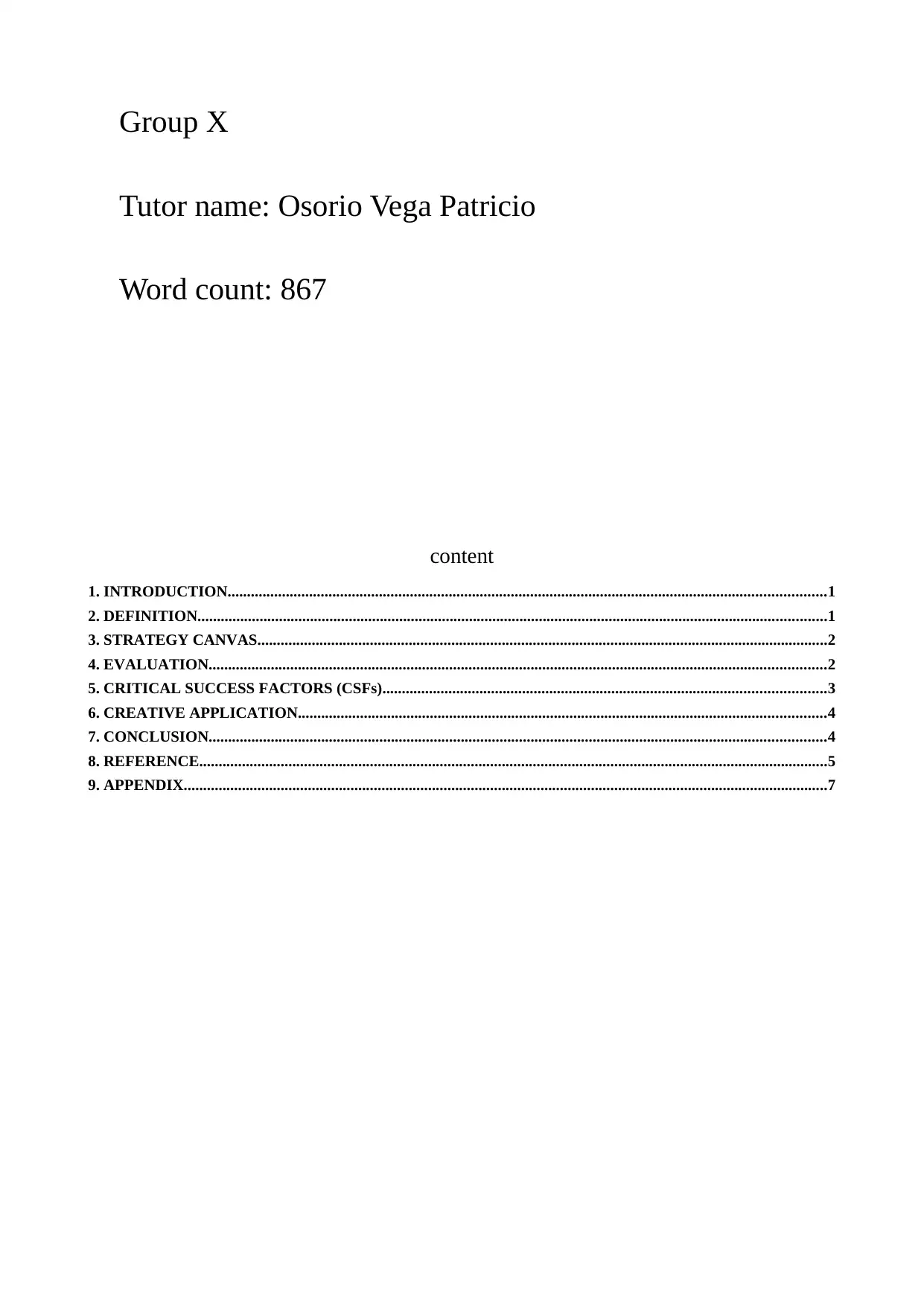
Group X
Tutor name: Osorio Vega Patricio
Word count: 867
content
1. INTRODUCTION..........................................................................................................................................................1
2. DEFINITION..................................................................................................................................................................1
3. STRATEGY CANVAS...................................................................................................................................................2
4. EVALUATION...............................................................................................................................................................2
5. CRITICAL SUCCESS FACTORS (CSFs)..................................................................................................................3
6. CREATIVE APPLICATION........................................................................................................................................4
7. CONCLUSION...............................................................................................................................................................4
8. REFERENCE..................................................................................................................................................................5
9. APPENDIX......................................................................................................................................................................7
Tutor name: Osorio Vega Patricio
Word count: 867
content
1. INTRODUCTION..........................................................................................................................................................1
2. DEFINITION..................................................................................................................................................................1
3. STRATEGY CANVAS...................................................................................................................................................2
4. EVALUATION...............................................................................................................................................................2
5. CRITICAL SUCCESS FACTORS (CSFs)..................................................................................................................3
6. CREATIVE APPLICATION........................................................................................................................................4
7. CONCLUSION...............................................................................................................................................................4
8. REFERENCE..................................................................................................................................................................5
9. APPENDIX......................................................................................................................................................................7

⊘ This is a preview!⊘
Do you want full access?
Subscribe today to unlock all pages.

Trusted by 1+ million students worldwide
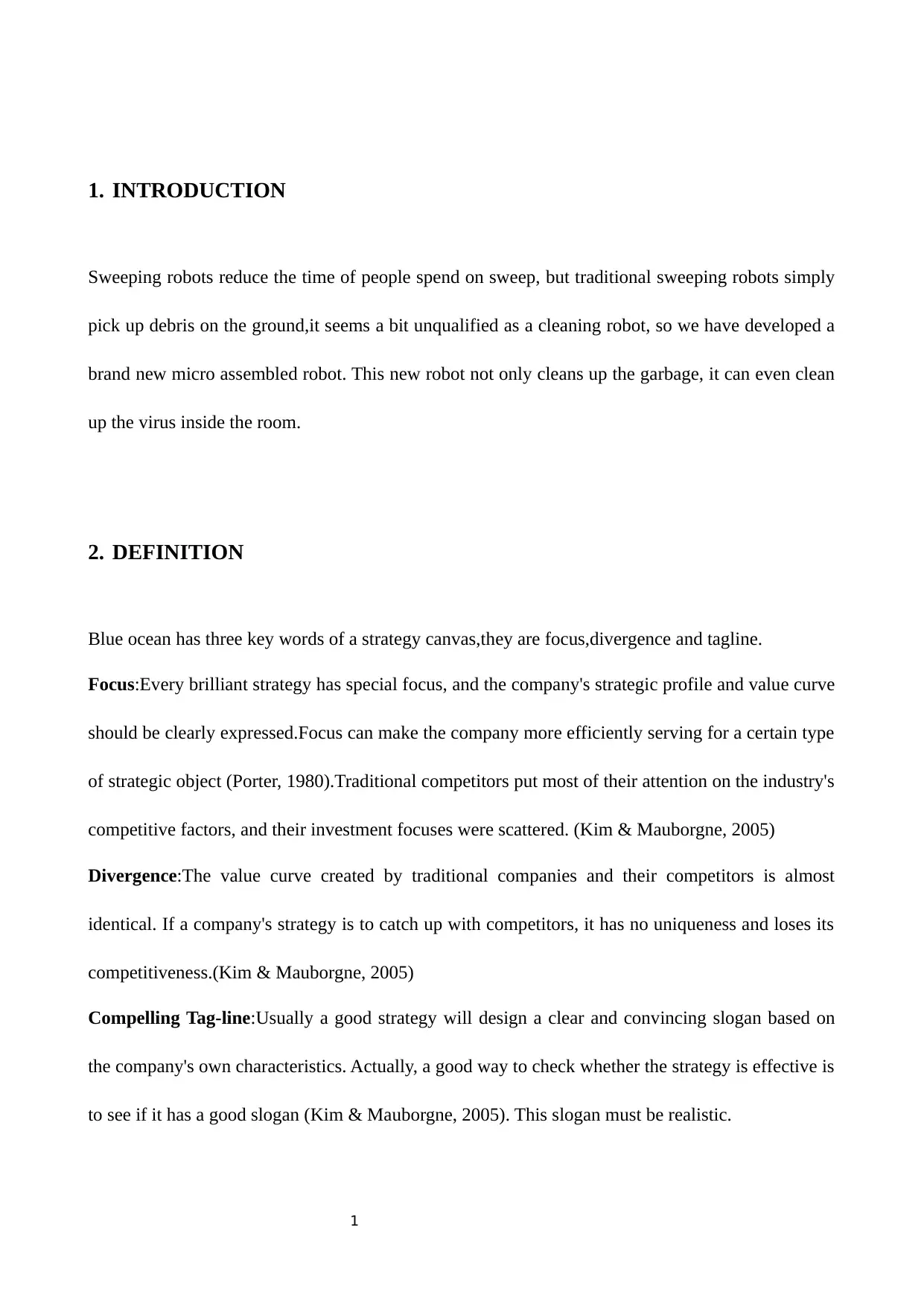
1
1. INTRODUCTION
Sweeping robots reduce the time of people spend on sweep, but traditional sweeping robots simply
pick up debris on the ground,it seems a bit unqualified as a cleaning robot, so we have developed a
brand new micro assembled robot. This new robot not only cleans up the garbage, it can even clean
up the virus inside the room.
2. DEFINITION
Blue ocean has three key words of a strategy canvas,they are focus,divergence and tagline.
Focus:Every brilliant strategy has special focus, and the company's strategic profile and value curve
should be clearly expressed.Focus can make the company more efficiently serving for a certain type
of strategic object (Porter, 1980).Traditional competitors put most of their attention on the industry's
competitive factors, and their investment focuses were scattered. (Kim & Mauborgne, 2005)
Divergence:The value curve created by traditional companies and their competitors is almost
identical. If a company's strategy is to catch up with competitors, it has no uniqueness and loses its
competitiveness.(Kim & Mauborgne, 2005)
Compelling Tag-line:Usually a good strategy will design a clear and convincing slogan based on
the company's own characteristics. Actually, a good way to check whether the strategy is effective is
to see if it has a good slogan (Kim & Mauborgne, 2005). This slogan must be realistic.
1. INTRODUCTION
Sweeping robots reduce the time of people spend on sweep, but traditional sweeping robots simply
pick up debris on the ground,it seems a bit unqualified as a cleaning robot, so we have developed a
brand new micro assembled robot. This new robot not only cleans up the garbage, it can even clean
up the virus inside the room.
2. DEFINITION
Blue ocean has three key words of a strategy canvas,they are focus,divergence and tagline.
Focus:Every brilliant strategy has special focus, and the company's strategic profile and value curve
should be clearly expressed.Focus can make the company more efficiently serving for a certain type
of strategic object (Porter, 1980).Traditional competitors put most of their attention on the industry's
competitive factors, and their investment focuses were scattered. (Kim & Mauborgne, 2005)
Divergence:The value curve created by traditional companies and their competitors is almost
identical. If a company's strategy is to catch up with competitors, it has no uniqueness and loses its
competitiveness.(Kim & Mauborgne, 2005)
Compelling Tag-line:Usually a good strategy will design a clear and convincing slogan based on
the company's own characteristics. Actually, a good way to check whether the strategy is effective is
to see if it has a good slogan (Kim & Mauborgne, 2005). This slogan must be realistic.
Paraphrase This Document
Need a fresh take? Get an instant paraphrase of this document with our AI Paraphraser
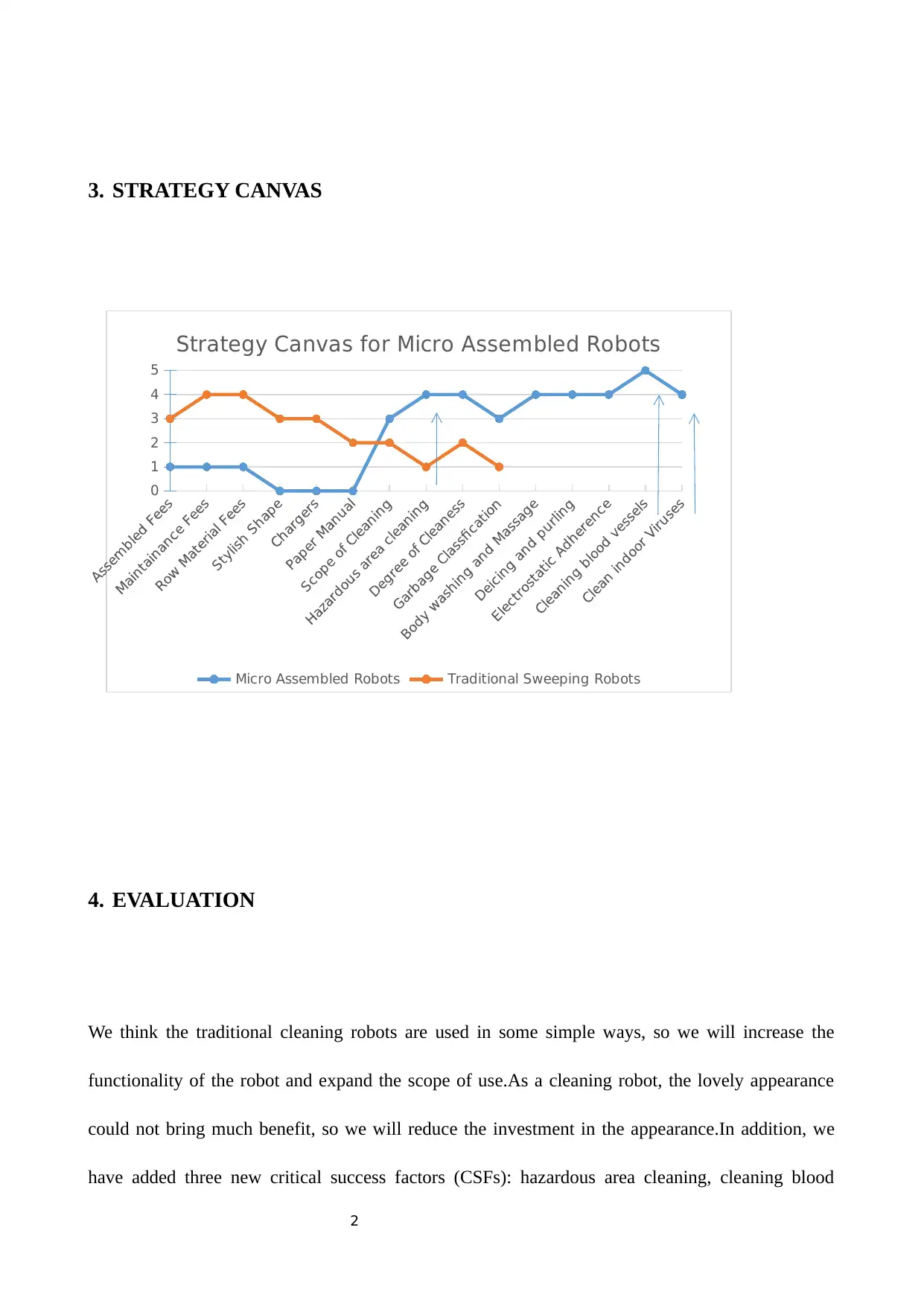
2
3. STRATEGY CANVAS
0
1
2
3
4
5
Strategy Canvas for Micro Assembled Robots
Micro Assembled Robots Traditional Sweeping Robots
4. EVALUATION
We think the traditional cleaning robots are used in some simple ways, so we will increase the
functionality of the robot and expand the scope of use.As a cleaning robot, the lovely appearance
could not bring much benefit, so we will reduce the investment in the appearance.In addition, we
have added three new critical success factors (CSFs): hazardous area cleaning, cleaning blood
3. STRATEGY CANVAS
0
1
2
3
4
5
Strategy Canvas for Micro Assembled Robots
Micro Assembled Robots Traditional Sweeping Robots
4. EVALUATION
We think the traditional cleaning robots are used in some simple ways, so we will increase the
functionality of the robot and expand the scope of use.As a cleaning robot, the lovely appearance
could not bring much benefit, so we will reduce the investment in the appearance.In addition, we
have added three new critical success factors (CSFs): hazardous area cleaning, cleaning blood
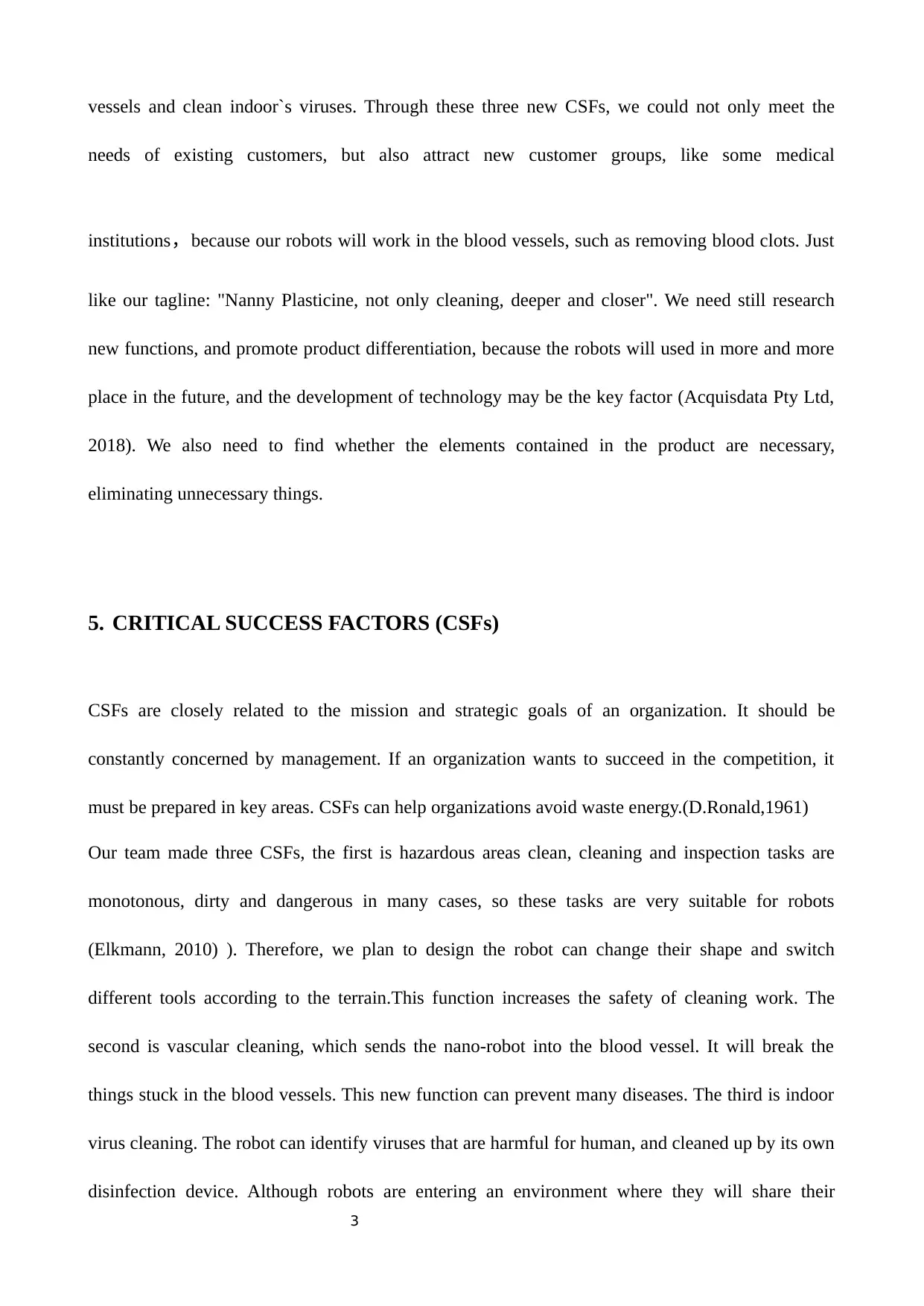
3
vessels and clean indoor`s viruses. Through these three new CSFs, we could not only meet the
needs of existing customers, but also attract new customer groups, like some medical
institutions,because our robots will work in the blood vessels, such as removing blood clots. Just
like our tagline: "Nanny Plasticine, not only cleaning, deeper and closer". We need still research
new functions, and promote product differentiation, because the robots will used in more and more
place in the future, and the development of technology may be the key factor (Acquisdata Pty Ltd,
2018). We also need to find whether the elements contained in the product are necessary,
eliminating unnecessary things.
5. CRITICAL SUCCESS FACTORS (CSFs)
CSFs are closely related to the mission and strategic goals of an organization. It should be
constantly concerned by management. If an organization wants to succeed in the competition, it
must be prepared in key areas. CSFs can help organizations avoid waste energy.(D.Ronald,1961)
Our team made three CSFs, the first is hazardous areas clean, cleaning and inspection tasks are
monotonous, dirty and dangerous in many cases, so these tasks are very suitable for robots
(Elkmann, 2010) ). Therefore, we plan to design the robot can change their shape and switch
different tools according to the terrain.This function increases the safety of cleaning work. The
second is vascular cleaning, which sends the nano-robot into the blood vessel. It will break the
things stuck in the blood vessels. This new function can prevent many diseases. The third is indoor
virus cleaning. The robot can identify viruses that are harmful for human, and cleaned up by its own
disinfection device. Although robots are entering an environment where they will share their
vessels and clean indoor`s viruses. Through these three new CSFs, we could not only meet the
needs of existing customers, but also attract new customer groups, like some medical
institutions,because our robots will work in the blood vessels, such as removing blood clots. Just
like our tagline: "Nanny Plasticine, not only cleaning, deeper and closer". We need still research
new functions, and promote product differentiation, because the robots will used in more and more
place in the future, and the development of technology may be the key factor (Acquisdata Pty Ltd,
2018). We also need to find whether the elements contained in the product are necessary,
eliminating unnecessary things.
5. CRITICAL SUCCESS FACTORS (CSFs)
CSFs are closely related to the mission and strategic goals of an organization. It should be
constantly concerned by management. If an organization wants to succeed in the competition, it
must be prepared in key areas. CSFs can help organizations avoid waste energy.(D.Ronald,1961)
Our team made three CSFs, the first is hazardous areas clean, cleaning and inspection tasks are
monotonous, dirty and dangerous in many cases, so these tasks are very suitable for robots
(Elkmann, 2010) ). Therefore, we plan to design the robot can change their shape and switch
different tools according to the terrain.This function increases the safety of cleaning work. The
second is vascular cleaning, which sends the nano-robot into the blood vessel. It will break the
things stuck in the blood vessels. This new function can prevent many diseases. The third is indoor
virus cleaning. The robot can identify viruses that are harmful for human, and cleaned up by its own
disinfection device. Although robots are entering an environment where they will share their
⊘ This is a preview!⊘
Do you want full access?
Subscribe today to unlock all pages.

Trusted by 1+ million students worldwide
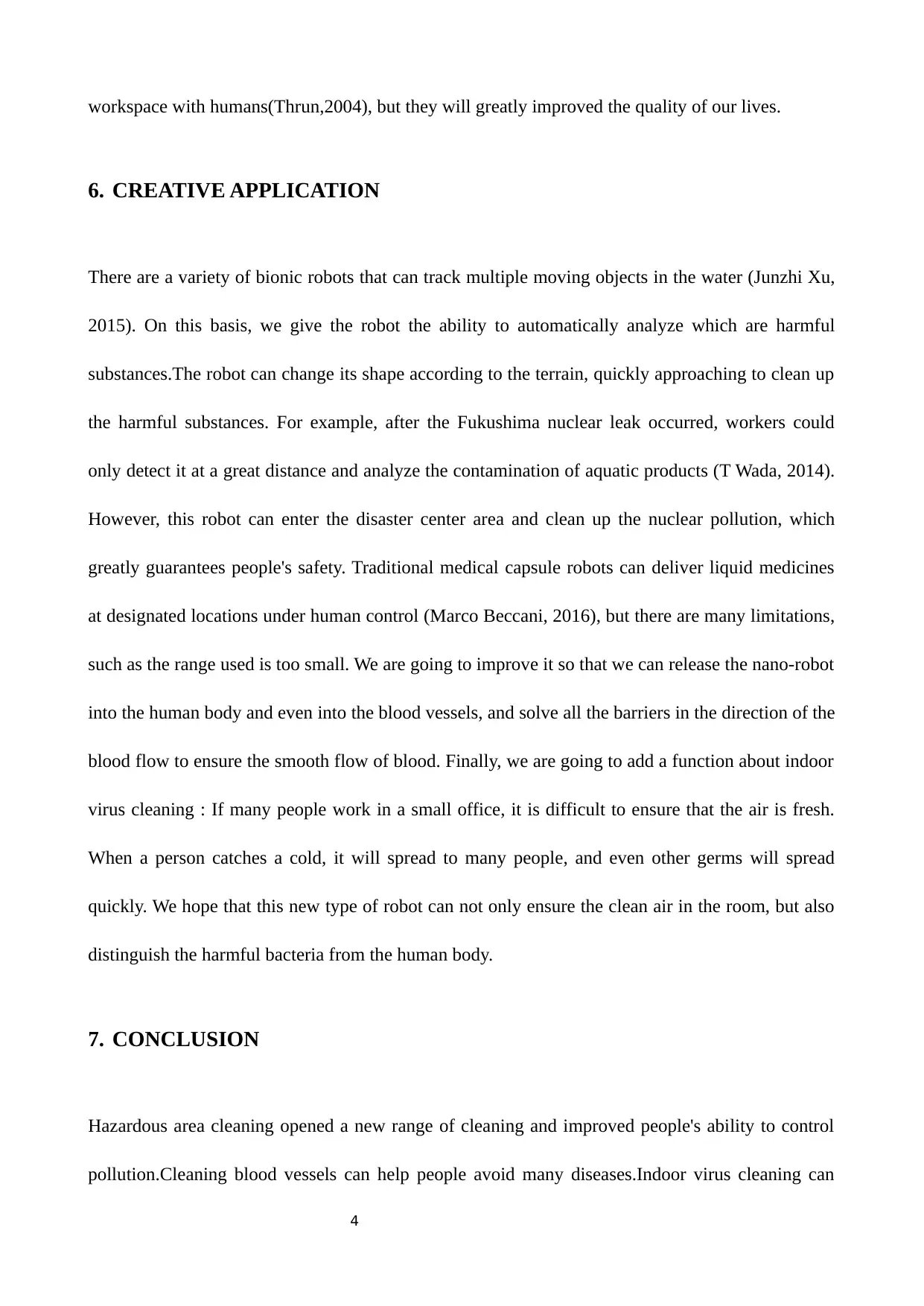
4
workspace with humans(Thrun,2004), but they will greatly improved the quality of our lives.
6. CREATIVE APPLICATION
There are a variety of bionic robots that can track multiple moving objects in the water (Junzhi Xu,
2015). On this basis, we give the robot the ability to automatically analyze which are harmful
substances.The robot can change its shape according to the terrain, quickly approaching to clean up
the harmful substances. For example, after the Fukushima nuclear leak occurred, workers could
only detect it at a great distance and analyze the contamination of aquatic products (T Wada, 2014).
However, this robot can enter the disaster center area and clean up the nuclear pollution, which
greatly guarantees people's safety. Traditional medical capsule robots can deliver liquid medicines
at designated locations under human control (Marco Beccani, 2016), but there are many limitations,
such as the range used is too small. We are going to improve it so that we can release the nano-robot
into the human body and even into the blood vessels, and solve all the barriers in the direction of the
blood flow to ensure the smooth flow of blood. Finally, we are going to add a function about indoor
virus cleaning : If many people work in a small office, it is difficult to ensure that the air is fresh.
When a person catches a cold, it will spread to many people, and even other germs will spread
quickly. We hope that this new type of robot can not only ensure the clean air in the room, but also
distinguish the harmful bacteria from the human body.
7. CONCLUSION
Hazardous area cleaning opened a new range of cleaning and improved people's ability to control
pollution.Cleaning blood vessels can help people avoid many diseases.Indoor virus cleaning can
workspace with humans(Thrun,2004), but they will greatly improved the quality of our lives.
6. CREATIVE APPLICATION
There are a variety of bionic robots that can track multiple moving objects in the water (Junzhi Xu,
2015). On this basis, we give the robot the ability to automatically analyze which are harmful
substances.The robot can change its shape according to the terrain, quickly approaching to clean up
the harmful substances. For example, after the Fukushima nuclear leak occurred, workers could
only detect it at a great distance and analyze the contamination of aquatic products (T Wada, 2014).
However, this robot can enter the disaster center area and clean up the nuclear pollution, which
greatly guarantees people's safety. Traditional medical capsule robots can deliver liquid medicines
at designated locations under human control (Marco Beccani, 2016), but there are many limitations,
such as the range used is too small. We are going to improve it so that we can release the nano-robot
into the human body and even into the blood vessels, and solve all the barriers in the direction of the
blood flow to ensure the smooth flow of blood. Finally, we are going to add a function about indoor
virus cleaning : If many people work in a small office, it is difficult to ensure that the air is fresh.
When a person catches a cold, it will spread to many people, and even other germs will spread
quickly. We hope that this new type of robot can not only ensure the clean air in the room, but also
distinguish the harmful bacteria from the human body.
7. CONCLUSION
Hazardous area cleaning opened a new range of cleaning and improved people's ability to control
pollution.Cleaning blood vessels can help people avoid many diseases.Indoor virus cleaning can
Paraphrase This Document
Need a fresh take? Get an instant paraphrase of this document with our AI Paraphraser
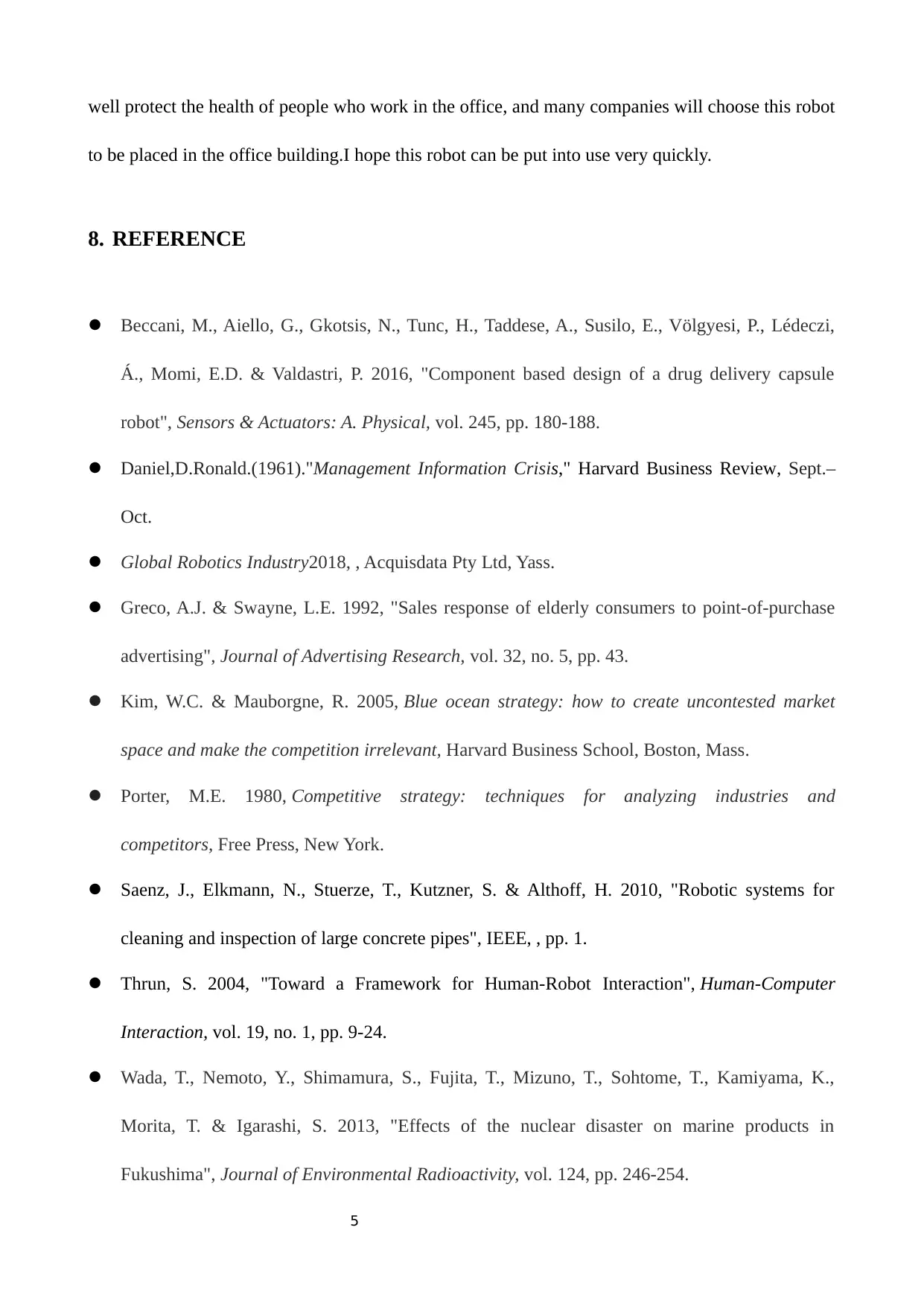
5
well protect the health of people who work in the office, and many companies will choose this robot
to be placed in the office building.I hope this robot can be put into use very quickly.
8. REFERENCE
Beccani, M., Aiello, G., Gkotsis, N., Tunc, H., Taddese, A., Susilo, E., Völgyesi, P., Lédeczi,
Á., Momi, E.D. & Valdastri, P. 2016, "Component based design of a drug delivery capsule
robot", Sensors & Actuators: A. Physical, vol. 245, pp. 180-188.
Daniel,D.Ronald.(1961)."Management Information Crisis," Harvard Business Review, Sept.–
Oct.
Global Robotics Industry2018, , Acquisdata Pty Ltd, Yass.
Greco, A.J. & Swayne, L.E. 1992, "Sales response of elderly consumers to point-of-purchase
advertising", Journal of Advertising Research, vol. 32, no. 5, pp. 43.
Kim, W.C. & Mauborgne, R. 2005, Blue ocean strategy: how to create uncontested market
space and make the competition irrelevant, Harvard Business School, Boston, Mass.
Porter, M.E. 1980, Competitive strategy: techniques for analyzing industries and
competitors, Free Press, New York.
Saenz, J., Elkmann, N., Stuerze, T., Kutzner, S. & Althoff, H. 2010, "Robotic systems for
cleaning and inspection of large concrete pipes", IEEE, , pp. 1.
Thrun, S. 2004, "Toward a Framework for Human-Robot Interaction", Human-Computer
Interaction, vol. 19, no. 1, pp. 9-24.
Wada, T., Nemoto, Y., Shimamura, S., Fujita, T., Mizuno, T., Sohtome, T., Kamiyama, K.,
Morita, T. & Igarashi, S. 2013, "Effects of the nuclear disaster on marine products in
Fukushima", Journal of Environmental Radioactivity, vol. 124, pp. 246-254.
well protect the health of people who work in the office, and many companies will choose this robot
to be placed in the office building.I hope this robot can be put into use very quickly.
8. REFERENCE
Beccani, M., Aiello, G., Gkotsis, N., Tunc, H., Taddese, A., Susilo, E., Völgyesi, P., Lédeczi,
Á., Momi, E.D. & Valdastri, P. 2016, "Component based design of a drug delivery capsule
robot", Sensors & Actuators: A. Physical, vol. 245, pp. 180-188.
Daniel,D.Ronald.(1961)."Management Information Crisis," Harvard Business Review, Sept.–
Oct.
Global Robotics Industry2018, , Acquisdata Pty Ltd, Yass.
Greco, A.J. & Swayne, L.E. 1992, "Sales response of elderly consumers to point-of-purchase
advertising", Journal of Advertising Research, vol. 32, no. 5, pp. 43.
Kim, W.C. & Mauborgne, R. 2005, Blue ocean strategy: how to create uncontested market
space and make the competition irrelevant, Harvard Business School, Boston, Mass.
Porter, M.E. 1980, Competitive strategy: techniques for analyzing industries and
competitors, Free Press, New York.
Saenz, J., Elkmann, N., Stuerze, T., Kutzner, S. & Althoff, H. 2010, "Robotic systems for
cleaning and inspection of large concrete pipes", IEEE, , pp. 1.
Thrun, S. 2004, "Toward a Framework for Human-Robot Interaction", Human-Computer
Interaction, vol. 19, no. 1, pp. 9-24.
Wada, T., Nemoto, Y., Shimamura, S., Fujita, T., Mizuno, T., Sohtome, T., Kamiyama, K.,
Morita, T. & Igarashi, S. 2013, "Effects of the nuclear disaster on marine products in
Fukushima", Journal of Environmental Radioactivity, vol. 124, pp. 246-254.
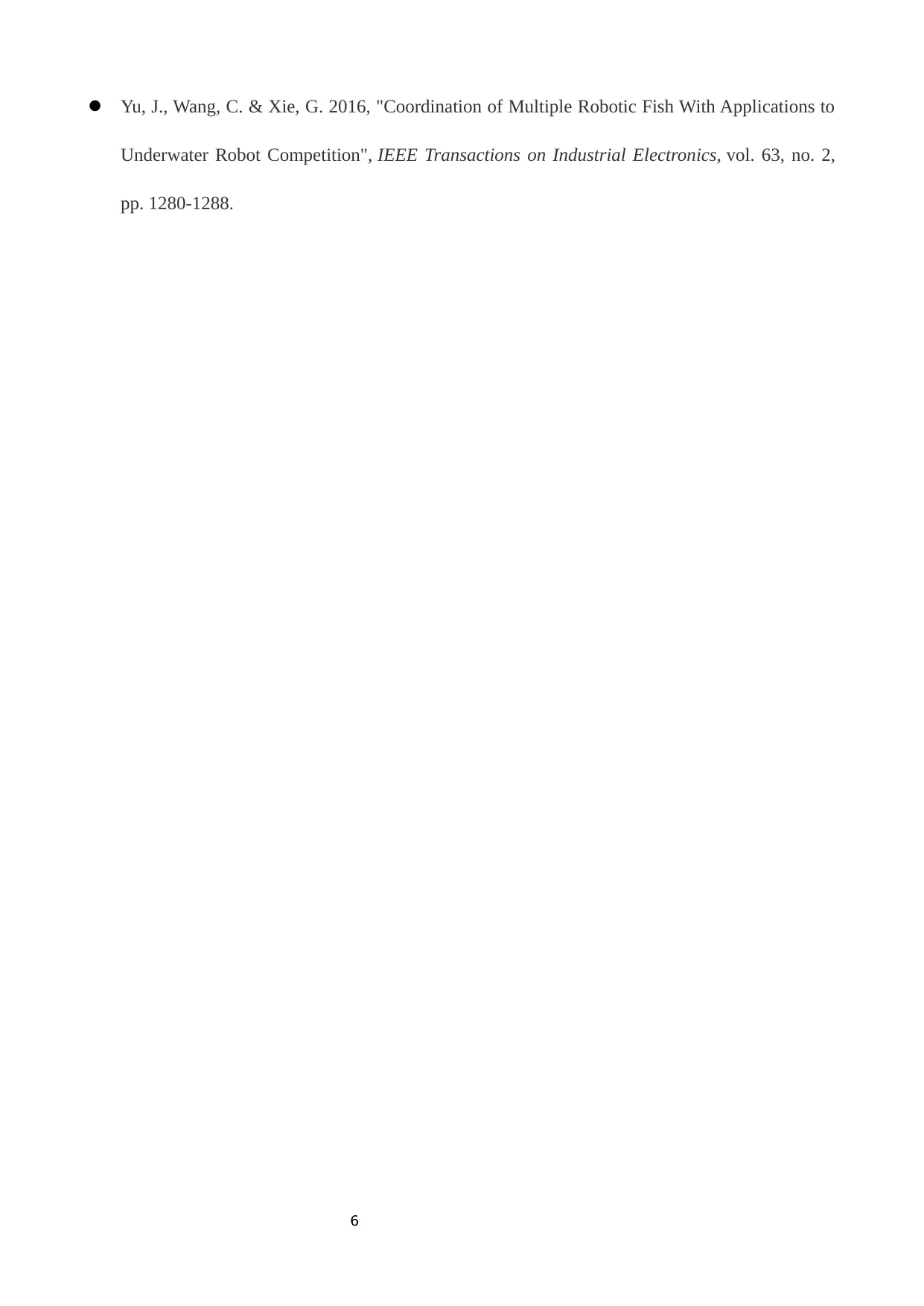
6
Yu, J., Wang, C. & Xie, G. 2016, "Coordination of Multiple Robotic Fish With Applications to
Underwater Robot Competition", IEEE Transactions on Industrial Electronics, vol. 63, no. 2,
pp. 1280-1288.
Yu, J., Wang, C. & Xie, G. 2016, "Coordination of Multiple Robotic Fish With Applications to
Underwater Robot Competition", IEEE Transactions on Industrial Electronics, vol. 63, no. 2,
pp. 1280-1288.
⊘ This is a preview!⊘
Do you want full access?
Subscribe today to unlock all pages.

Trusted by 1+ million students worldwide
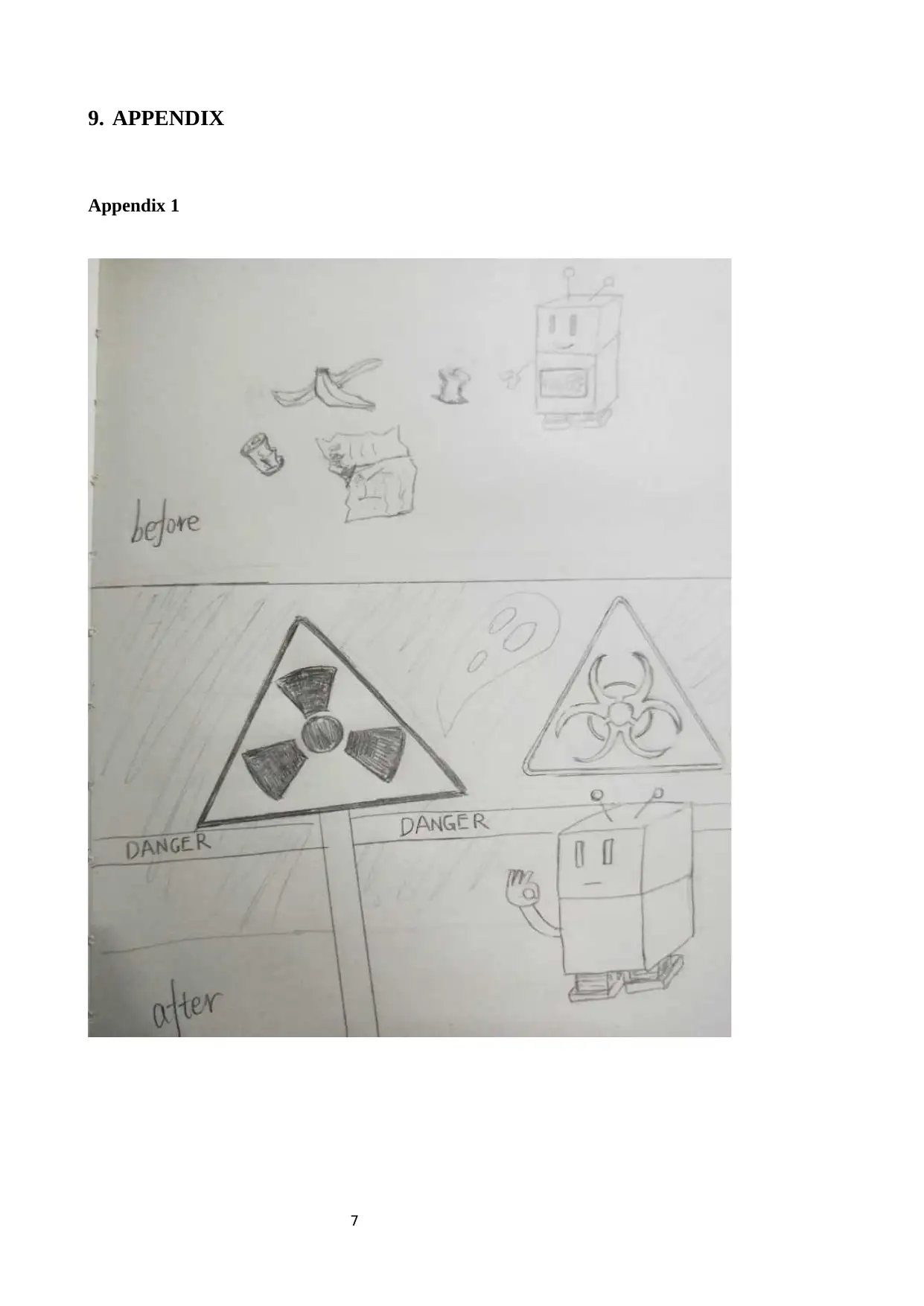
7
9. APPENDIX
Appendix 1
9. APPENDIX
Appendix 1
Paraphrase This Document
Need a fresh take? Get an instant paraphrase of this document with our AI Paraphraser
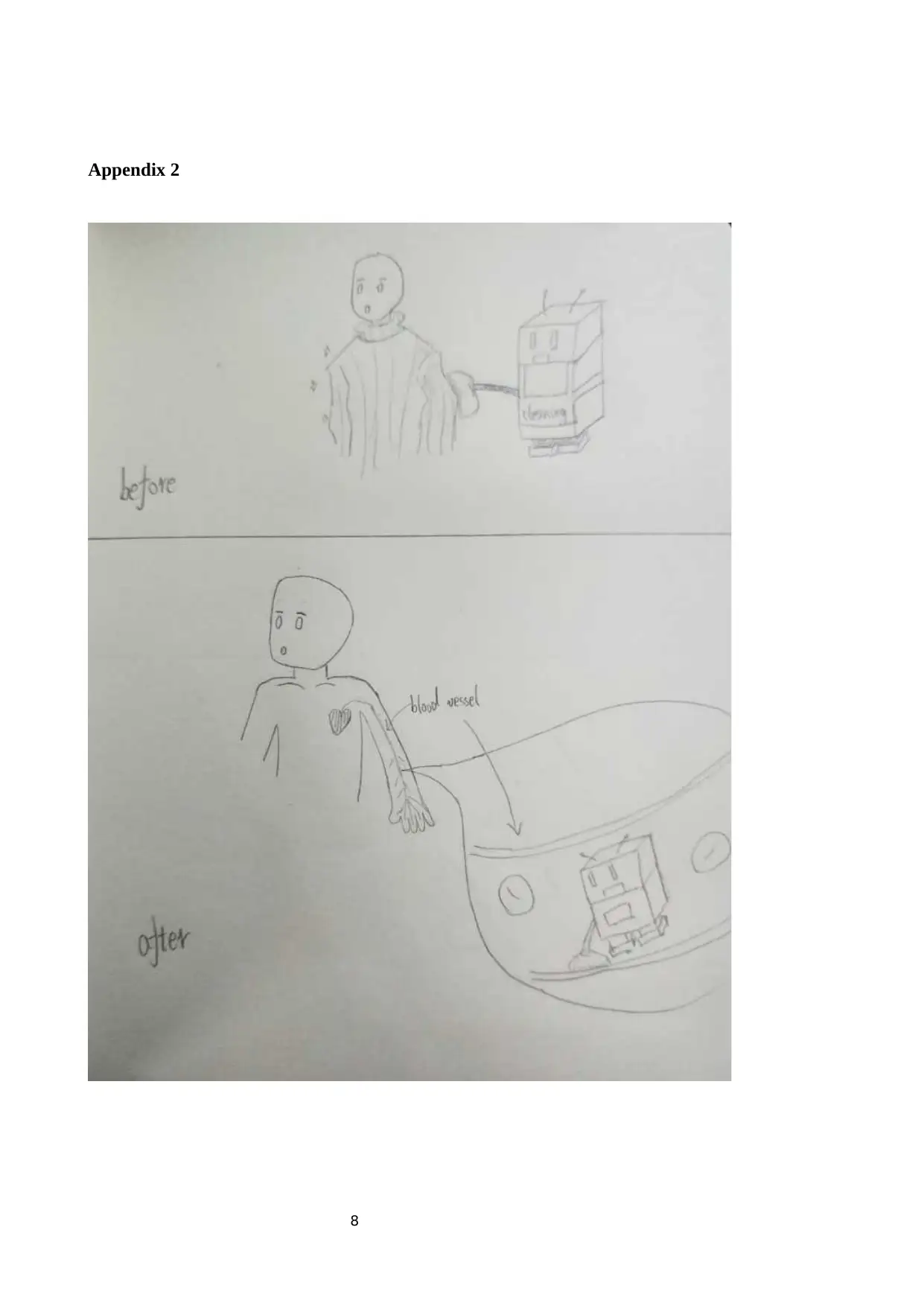
8
Appendix 2
Appendix 2
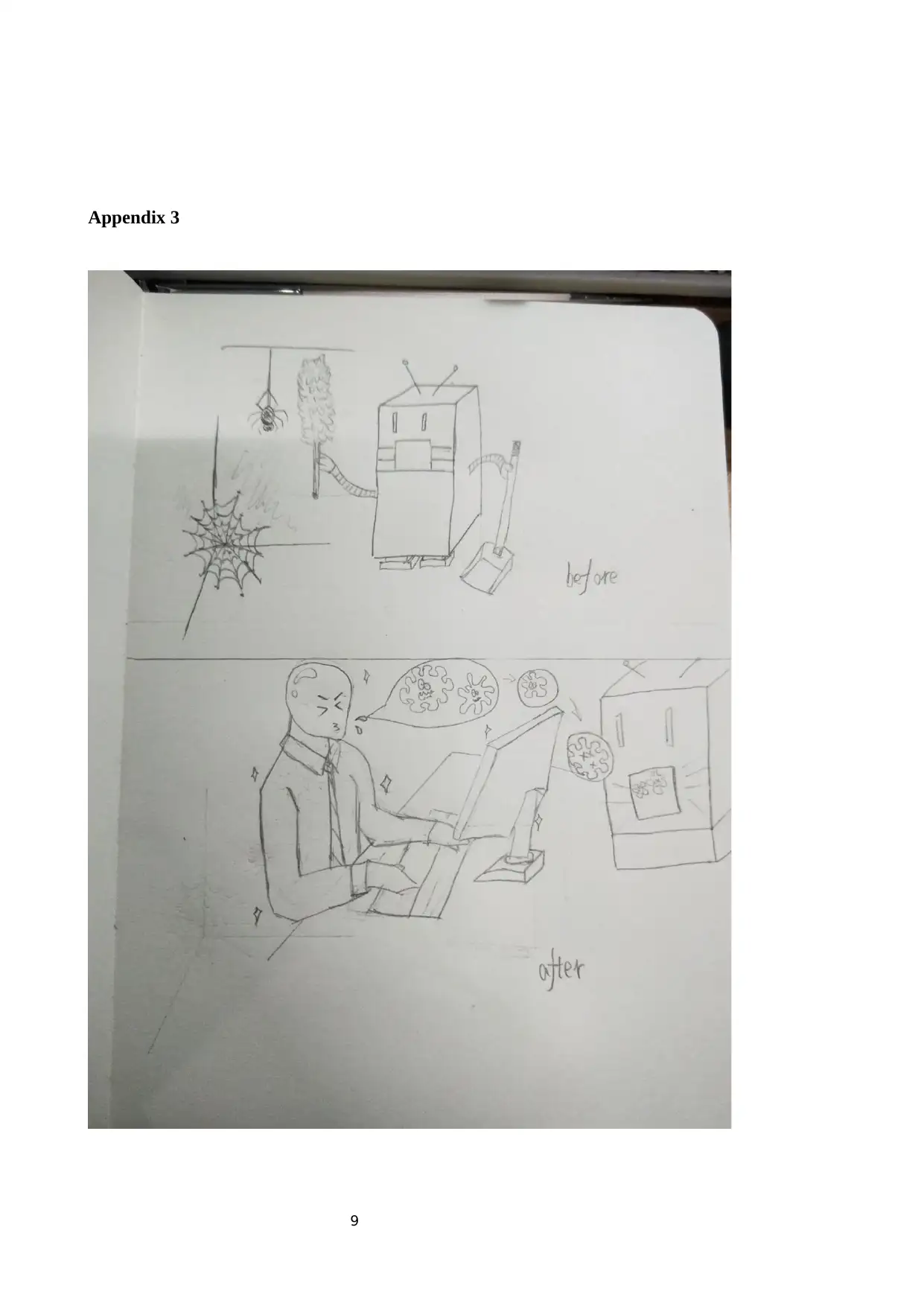
9
Appendix 3
Appendix 3
⊘ This is a preview!⊘
Do you want full access?
Subscribe today to unlock all pages.

Trusted by 1+ million students worldwide
1 out of 12
Your All-in-One AI-Powered Toolkit for Academic Success.
+13062052269
info@desklib.com
Available 24*7 on WhatsApp / Email
![[object Object]](/_next/static/media/star-bottom.7253800d.svg)
Unlock your academic potential
Copyright © 2020–2025 A2Z Services. All Rights Reserved. Developed and managed by ZUCOL.